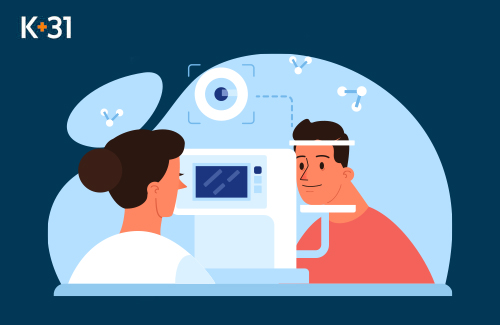Retinal dystrophy: types of disease and treatment methods

When, for some reason, blood circulation and metabolism in the tissues of the retina are disrupted, dystrophic changes in the retina begin. This process is irreversible and without timely medical care can lead to complete loss of vision.
The disease varies in etiology and location of the lesion. Depending on this, treatment of retinal dystrophy is prescribed.
Types of retinal dystrophy
Retinal dystrophy in origin can be inherited or acquired.
1. Congenital types include:
- retinal pigmentary dystrophy;
- spot-white retinal dystrophy.
Genetically inherited forms of retinal dystrophy only progress with age, and it is impossible to completely cure them. Therapy can only slow down the process.
2. Acquired types of retinal dystrophy:
- central dystrophy;
- peripheral dystrophy.
Pathology of this type is treatable, but the result depends on the timeliness of contacting a doctor. The sooner this happens, the greater the likelihood of returning the patient to the maximum possible visual acuity.
Generalized dystrophy is also distinguished, in which damage affects the entire surface of the retina.
Types of peripheral retinal dystrophy
Peripheral retinal dystrophy is damage and death of cells at the edges of the retina due to their lack of nutrition. The exact causes of retinal dystrophy have not yet been determined, but there are provoking factors:
- heredity;
- refractive errors (myopia, hypermetropia, astigmatism);
- age (over 50 years old);
- various eye injuries;
- chronic diseases of an autoimmune nature or associated with the vascular system;
- infectious and inflammatory eye lesions.
At first, fundus dystrophy is asymptomatic, without causing any discomfort in a person, but this is the danger. When the irreversible process affects most of the retina, symptoms such as:
- lack of lateral vision, poor coordination in space;
- appearance of floating flies or dots in the field of view;
- general deterioration in the quality of vision, especially in the dark.
In such cases, it is necessary to urgently begin treatment of retinal dystrophy in order to avoid serious complications.
There are several types of peripheral chorioretinal dystrophy of the retina.
- Lattice type. The most dangerous type of dystrophy is often detected in patients with retinal detachment. The name is associated with the pattern of the fundus, which is observed by the doctor during examination.
- Like a “snail trail”. The affected area looks like a shiny ribbon with white spots - breaks, similar to the trail that a snail leaves when it moves. Dystrophy of this type often provokes large tears and retinal detachment.
- Like a “cobblestone street”. A characteristic pattern is observed in the form of light round spots along the edges of the retina. Rarely leads to retinal tears and detachment.
The main difficulty in the timely detection of peripheral retinal dystrophy is that the disease develops for a long time without pronounced symptoms.
Types of central retinal dystrophy
With central retinal dystrophy, the cells of the macula, the central region of the retina through which image impulses are transmitted to the visual part of the brain, are destroyed. Age-related macular degeneration is a disease that leads to deterioration of central vision.
The main cause of AMD is the general irreversible process of aging of the body. But dystrophy can also be a consequence of eye injury, previous infections, high degree of myopia, or genetic predisposition.
Main symptoms of AMD:
- curvature of straight lines, blurring of the image;
- difficulty with reading and fine work;
- decrease in image brightness, general deterioration of vision.
The early stage of macular degeneration of the retina has the appearance of a dry form and is better treated. But without proper treatment, the process quickly progresses, and the disease turns into a more aggressive wet form.
Whether retinal dystrophy can be treated in adultsover 50 years of age is difficult to say. It all depends on how early the person went to the doctor. But in any case, AMD cannot be completely cured.
Treatment methods
The causes of retinal dystrophy and treatment are interconnected. In case of peripheral dystrophy, laser cauterization of the retina in the affected areas helps stop the development of pathology.
With the dry form of age-related macular degeneration, it is enough to give up bad habits, switch to a healthy diet that improves metabolism in retinal cells, and monitor the process. Wet AMD without drug treatment can lead to complete loss of vision.
Let's look at how retinal dystrophy is treated in different ways.
- Medicinal. First, the doctor, using therapeutic agents, tries to improve the blood supply to the eyes, improve metabolism, and strengthen the walls of blood vessels. If medications do not have the desired effect, intravitreal injections are prescribed. The drug enters directly into the retinal tissue, which increases the effectiveness of therapy. For wet AMD, the necessary medications are injected into the vitreous.
- Laser coagulation of the retina. This method today is the most common form of medical care for the onset of retinal detachment. The laser beam “welds” it at damaged points to adjacent tissues, which stops the process of delamination and strengthens this eye structure. The disease stops progressing.
- Surgical methods. In case of serious damage to the retina, surgery is performed to remove excess fluid, replace the vitreous, and in some cases, retinal transplantation.
Like any other pathology, retinal dystrophy is easier to treat and stabilize at the very beginning of its development. But due to the fact that the process does not manifest itself in any way, and at the same time continues to progress, there is a risk of developing severe complications, including complete blindness. This is why it is so important to undergo an annual ophthalmological examination, even if there are no problems with vision.
